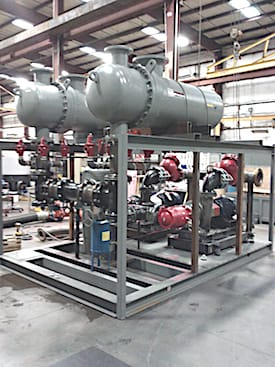Making the case for hydronics: three advantages of water-based HVAC systems over VRF
In an ongoing effort to meet the comfort, cost and energy-efficiency expectations of the commercial building industry, design engineers, building owners and mechanical contractors are constantly re-examining the technology and components of HVAC systems.
Hydronic systems and variable refrigerant flow (VRF) systems are two heating and cooling systems often compared in terms of energy consumption and system performance. Since entering the U.S. market, VRF systems have garnered interest for their space-saving ductless technology and claims of exceptional energy efficiency. However, industry studies demonstrate how hydronic systems are more energy efficient than VRF systems.
About the systems
Hydronic systems provide water-based heating and cooling through pipes and other components such as pumps, drives, controls, heat exchangers and valves that deliver heated or cooled air via an air-handling unit through ductwork and air terminals. VRF systems, on the other hand, use refrigerant as the primary heating/cooling medium and are comprised of a main compressor unit connected through refrigerant lines to multiple indoor cassette units than can be individually controlled.
Whether selecting HVAC systems for new construction or retrofits, there are three main advantages to choosing a hydronic system versus VRF.
- Lower costs
Hydronic systems are budget friendly. Upfront, maintenance and lifestyle costs are low compared to VRF systems.
When designing a hydronic system, mechanical contractors and specifying engineers can control costs based on selection of technology. With few options available, there is virtually no variation in the upfront cost of VRF systems.
Hydronic systems are also affordable to maintain. Designed with universal components, the systems can be installed and serviced by any trained HVAC service technician. What’s more, hydronic systems are upgradeable and expandable.
Conversely, VRF systems are proprietary. This restricts the ability to substitute components from different manufacturers. The proprietary nature of VRF systems also requires specialized technicians for the life of the system, from installation to adjustments to repairs, adding to the lifecycle costs.
It is important to note that hydronic systems have a longer life expectancy than VRF systems. A hydronic system has been known to last 25 to 30 years, whereas VRF systems may need to be replaced 10 to 15 years after installation.
- Versatility
Hydronic systems are easily adaptable to a wide range of energy sources from natural gas and propane to solar thermal collectors and biomass boilers. In contrast, VRF systems are solely sourced by electricity.
Additionally, hydronic systems are less affected by extreme temperature changes than VRF systems. The efficiency of a VRF system is reduced as the ambient temperature increases in the cooling mode and decreases in the heating mode. In cold climates, VRF systems may require a supplementary heat source, such as hot water from a boiler, which may negate the energy efficiency of the system.
 Water-based hydronic systems like a water-sourced heat pump system can draw the heat or chill from a room and carry that energy back to the system for later use. This reduces energy consumption and costs. Although a VRF system can provide zoned comfort, recovering heat from one zone to use it in another, it does not have thermal storage capabilities.
Water-based hydronic systems like a water-sourced heat pump system can draw the heat or chill from a room and carry that energy back to the system for later use. This reduces energy consumption and costs. Although a VRF system can provide zoned comfort, recovering heat from one zone to use it in another, it does not have thermal storage capabilities.
- Safety and reliability
While it’s possible for leaks to develop in both hydronic and VRF systems, a leak in a VRF system is potentially life threatening because a VRF system usually contains a high volume of refrigerant that can asphyxiate building occupants. Refrigerant leaks also cannot be detected by sight or smell, making them difficult to locate and repair.
Hydronic systems with cooling units require refrigerant to operate, however they use 66 to 75% less refrigerant on average according to the Hydraulic Industry Alliance. Refrigerant circuits in a hydronic system are factory-sealed, meaning the units are assembled in a controlled environment and subjected to rigorous standards and testing prior to installation. Conversely, VRF systems use both factory-sealed and field-installed circuits, which require brazing and soldering of copper piping on site. The quality of installation depends on the technician’s level of expertise. VRF technicians must be qualified to work with refrigerants under extremely high pressure and be knowledgeable about leak detection and ventilation requirements per ASHRAE Standard 15.
As the most comfortable, cost-efficient and reliable heating and cooling source available today, hydronic systems will continue to be the leading technology for commercial applications.
Kyle DelPiano is market development manager, Southeast Territory, Xylem Inc. He is an active ASHRAE member and LEED AP certified.
The information conveyed in this article are the views of the author.






Join the conversation: